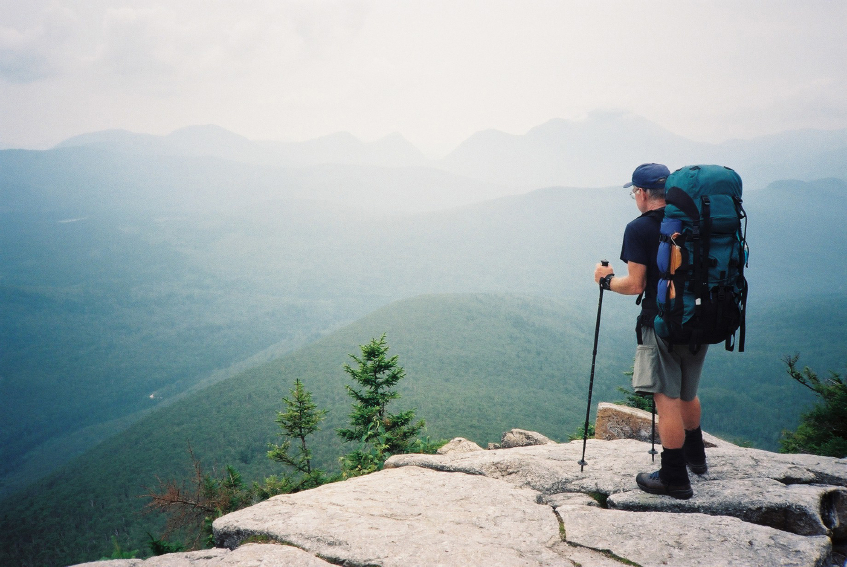Hitting the Trail: Baylor Environmental Scientist Examines the Spiritual Side of Hiking a Footpath through the Appalachians

Baylor University professor has researched spiritual aspect of hiking the Appalachian Trail.
(iStockphoto image)
Media Contact: Terry Goodrich, (254) 710-3321
Follow us on Twitter:@BaylorUMedia
WACO, Texas (Sept. 24, 2012) -- When people set out on a 2,180-mile trail, they may be looking for recreation, gorgeous landscapes or an escape from day-to-day existence. But the Appalachian Trail, which passes through 14 states from Georgia to Maine, also has become a modern-day pilgrimage rather than a mere journey through the woods.
Each year, an estimated 2 million to 3 million people visit the trail -- dubbed AT -- with almost 2,000 of those attempting a "thru-hike" of the entire distance, said Susan Bratton, Ph.D., a Baylor University professor of environmental science. She's an aficionado of the trail as well as a researcher of its spiritual dimension for those who make the journey.
Bratton has written a book, The Spirit of the Appalachian Trail: Community, Environment, and Belief (University of Tennessee Press), which has been nominated for The Crader Family Book Prize. The award recognizes a book exemplifying the American values of individual liberty, constitutional principles and civic virtue.
"Hikers often speak of how their experience as thru-hikers changes them spiritually, but this is the first study to evaluate these religious or quasi-religious claims critically," said Bratton, who teaches in Baylor's College of Arts & Sciences.
Besides hiking the trail through the years, Bratton has investigated why others hike, talking with them and reading their trail journals. More than 200 hikers responded to a lengthy survey, and Bratton also got input from "Trail Angels" -- volunteers in small towns on the trail who aid hikers in need of food, shelter and sometimes medical and spiritual care.
"Some hikers have very intense religious experiences on the Trail, including interactions with natural features," Bratton said. "About a third reported experiencing God in nature, or the trail as a spiritual environment . . . Some are very social and find fulfillment in camaraderie and constant interactions with new people. Others are very oriented toward the journey itself - accomplishing mileage, crossing the highest points. Some are just getting away from their day-to-day lives. Disciplined mysticism is rare, however. For most hikers who report a religious or spiritual experience, it is a secondary priority."
One finding is that frequency of prayer or meditation correlated to making a hiker feel more positive about life and promoting physical or emotional healing.
From a personal standpoint, "Some of my greatest aesthetic and natural history experiences have been on the AT --memorable wildflowers, sunsets and even meteor showers," Bratton said. "I've met interesting people and had some great conversations around the camp stove. I also find the Trail to be a friendly environment for conversations with God."
ABOUT BAYLOR UNIVERSITY
Baylor University is a private Christian university and a nationally ranked research institution, characterized as having "high research activity" by the Carnegie Foundation for the Advancement of Teaching. The university provides a vibrant campus community for approximately 15,000 students by blending interdisciplinary research with an international reputation for educational excellence and a faculty commitment to teaching and scholarship. Chartered in 1845 by the Republic of Texas through the efforts of Baptist pioneers, Baylor is the oldest continually operating university in Texas. Located in Waco, Baylor welcomes students from all 50 states and more than 80 countries to study a broad range of degrees among its 11 nationally recognized academic divisions. Baylor sponsors 19 varsity athletic teams and is a founding member of the Big 12 Conference.
ABOUT BAYLOR COLLEGE OF ARTS & SCIENCES
The College of Arts & Sciences is Baylor University's oldest and largest academic division, consisting of 26 academic departments and 13 academic centers and institutes. The more than 5,000 courses taught in the College span topics from art and theatre to religion, philosophy, sociology and the natural sciences. Faculty conduct research around the world, and research on the undergraduate and graduate level is prevalent throughout all disciplines. Visit www.baylor.edu/artsandsciences